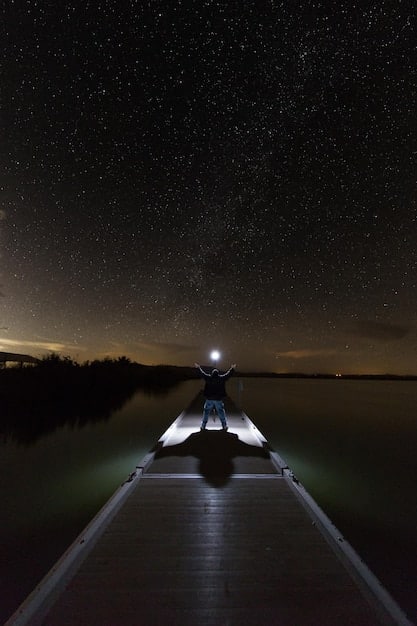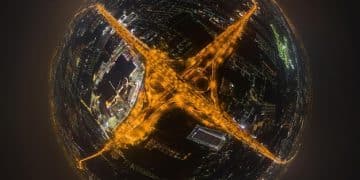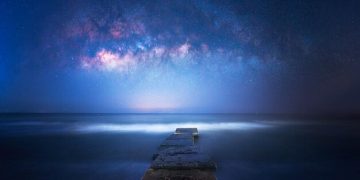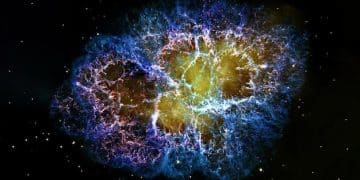2025 Meteor Showers Guide: Best Viewing Dates & Locations in the US

2025’s major meteor showers offer a spectacular celestial display for US viewers, with key events like the Perseids in August and the Geminids in December providing the most stunning opportunities for observation with optimal dark sky conditions.
Get ready to witness the cosmic ballet of 2025’s major meteor showers! This guide provides key dates, viewing tips, and the best locations across the US to experience these celestial events.
Understanding Meteor Showers
Meteor showers are celestial events where numerous meteors are observed to radiate from one point in the night sky. These meteors are caused by streams of cosmic debris called meteoroids entering Earth’s atmosphere at extremely high speeds on parallel trajectories.
When do meteor showers happen and why? These events occur annually or at regular intervals as the Earth passes through the debris left behind by comets and, in some cases, asteroids. This debris consists of small particles, often no larger than a grain of sand, which burn up upon entering the Earth’s atmosphere, creating the streaks of light we know as meteors.
The Science Behind Meteor Showers
The radiant, the point in the sky from which the meteors appear to originate, is a key characteristic of each meteor shower. The shower is named after the constellation in which this radiant is located. For example, the Perseids appear to come from the constellation Perseus.
Meteor showers are more intense when the Earth passes through a denser part of the debris stream. The intensity is also affected by the position of the radiant in the sky; showers are generally better seen after midnight when the radiant is higher in the sky.
- Meteor showers occur when Earth passes through cosmic debris left by comets and asteroids.
- The radiant point is the area in the sky from which the meteors appear to originate.
- Shower intensity varies based on the density of the debris and radiant’s position.
Understanding the basics of meteor showers can significantly enhance your viewing experience, allowing you to anticipate and appreciate the celestial spectacle with greater knowledge and excitement.
Prime Meteor Showers to Watch in 2025
As 2025 approaches, anticipation builds for the year’s most stunning meteor showers. Knowing when to look up is the first step in experiencing these cosmic events.
Here are some of the prime meteor showers to mark on your calendar for 2025, complete with dates and viewing tips. These showers consistently offer the most spectacular displays, and with strategic planning, you can catch them at their best.

Quadrantids (Early January)
The Quadrantids shower is active in early January. Despite its brief peak, it can produce a high number of meteors under optimal conditions. To catch the Quadrantids, find a dark location away from city lights and look towards the constellation Boötes.
Perseids (Mid-August)
The Perseids meteor shower is one of the most popular meteor showers of the year. Occurring in mid-August, it often offers bright and frequent meteors. For the best viewing experience, seek out a dark location and look towards the constellation Perseus. Avoiding light pollution is crucial for seeing fainter meteors.
- Quadrantids: Active in early January with a very short peak.
- Perseids: Occurs in mid-August offering bright and frequent meteors.
- Both showers require dark skies away from city lights for best viewing.
Staying informed about these meteor showers allows you to plan ahead and increase your chances of witnessing their breathtaking displays. Each meteor shower brings its unique characteristics to the night sky, providing ample opportunity for awe and wonder.
Best Viewing Locations in the US
The viewing experience of a meteor shower is heavily influenced by the location. Urban areas with high levels of light pollution severely diminish the visibility of meteors.
Here’s a guide to some of the best dark sky locations in the US, where you can maximize your chances of seeing these celestial shows. These spots are known for their minimal light pollution and accessible viewing conditions.
Dark Sky Parks
Dark Sky Parks are designated areas recognized for their commitment to preserving dark skies. They offer ideal viewing environments with minimal light interference. Parks like Death Valley National Park in California and Cherry Springs State Park in Pennsylvania are premier locations.
Rural Areas
Venturing into rural areas away from major cities is another excellent strategy. The vast open spaces and reduced artificial lighting provide better visibility. Consider states such as Montana, Wyoming, and the Dakotas, which have large expanses of sparsely populated land.

- Dark Sky Parks offer minimal light interference for optimal viewing.
- Rural areas provide expansive, dark viewing opportunities.
- Locations in the western and northern states tend to have less light pollution.
Choosing the right location significantly increases your chances of seeing more meteors and enjoying the full brilliance of a meteor shower, making the experience truly memorable.
Tips for Optimal Meteor Shower Viewing
To make the most of a meteor shower viewing, it’s essential to be well-prepared. Simple adjustments to your viewing setup and habits can dramatically enhance your experience.
Here are several tips for improving your meteor shower viewing, ensuring you don’t miss any of the action and stay comfortable throughout the night.
What to Bring
Bring comfortable seating, like a reclining chair or blanket, to avoid neck strain. Also, pack warm clothing, a thermos with a hot beverage, and snacks. A red flashlight is useful for preserving your night vision.
How to Prepare your Eyes
Acclimate your eyes to the darkness for at least 20-30 minutes before viewing. Avoid looking at bright screens, as the light can impair your night vision.
- Bring comfortable seating and warm clothing for extended viewing.
- Acclimate your eyes to darkness before looking at the sky.
- Use a red flashlight to preserve night vision.
By following these tips, you can transform a simple night under the stars into an unforgettable cosmic adventure. Proper preparation ensures that you are comfortable, focused, and ready to witness the wonders of a meteor shower.
Understanding Moon Phases and Their Impact
The moon’s phase plays a significant role in determining the visibility of meteor showers. A bright, full moon can wash out fainter meteors, reducing the number you can see.
Here’s how the moon phases can affect your meteor shower viewing and what to consider when planning your observations. Understanding the interplay between lunar light and meteor visibility is key to maximizing your viewing experience.
New Moon vs. Full Moon
A new moon, when the moon is not visible in the night sky, provides the darkest conditions, making it ideal for meteor viewing. Conversely, a full moon can significantly reduce the number of visible meteors, as its brightness overpowers the fainter streaks of light.
Best Strategies to Avoid Moon Glare
Check the lunar calendar before planning your meteor shower viewing. If a full moon coincides with a major shower, consider observing during the early morning hours when the moon is lower in the sky. Also, position yourself so that the moon is behind you, minimizing direct glare.
- New moons create the darkest skies, ideal for meteor viewing.
- Full moons can diminish visibility by washing out fainter meteors.
- Check the lunar calendar and observe when the moon is low or behind you.
Being mindful of the moon’s phase will greatly improve your meteor shower viewing. By planning your observations around the lunar cycle, you can increase your chances of witnessing the full glory of these celestial events.
Capturing Meteor Showers with Photography
Photographing meteor showers can be both challenging and rewarding. With the right equipment and techniques, you can capture stunning images of these fleeting cosmic events.
Here’s a guide to capturing meteor showers with photography. These tips will help you take amazing photographs of meteors streaking across the night sky.
Essential Equipment
You’ll need a DSLR or mirrorless camera, a wide-angle lens (preferably with a fast aperture, like f/2.8 or wider), a sturdy tripod, and a remote shutter release. These tools will allow you to capture clear, stable images over long exposures.
Camera Settings
Use a high ISO (between 1600 and 6400), a wide aperture (f/2.8 or the widest your lens allows), and a long exposure time (15-30 seconds). Experiment with different settings to find what works best for your location and equipment.
- Use a DSLR or mirrorless camera with a wide-angle lens and a sturdy tripod.
- Set a high ISO, wide aperture, and long exposure time.
- Focus manually on a distant bright star for sharp images.
By understanding these techniques, you can transform a simple night under the stars into an unforgettable cosmic adventure.
| Key Aspect | Brief Description |
|---|---|
| 🌠 Prime Showers | Perseids & Geminids offer the most spectacular displays. |
| 🌃 Dark Locations | Rural areas and Dark Sky Parks provide the best viewing. |
| 🌙 Moon Phases | New moon phases offer the darkest skies for optimal viewing. |
| 📸 Photography Tips | Use wide-angle lens & long exposure for stunning captures.. |
Frequently Asked Questions
▼
The best time to view a meteor shower is usually after midnight until dawn. The radiant point rises higher in the sky, increasing the likelihood of seeing more meteors. Make sure to check the specific peak times for each shower.
▼
Use the International Dark-Sky Association (IDA) website or apps like Dark Sky Finder to locate certified Dark Sky Parks and other areas with low light pollution near you. These resources offer maps and ratings for sky darkness.
▼
Meteor showers occur annually because Earth’s orbit intersects with the orbits of comets and asteroids whose debris trails create these events. We pass through these trails at the same time each year.
▼
No, you don’t need a telescope to view meteor showers. Meteors are best observed with the naked eye. Telescopes and binoculars narrow your field of view, making it harder to spot the fast-moving streaks of light.
▼
If the weather is cloudy on the peak night, try observing on the nights leading up to or following the peak. Meteor showers often have activity a few days before and after the predicted peak, so you may still catch some meteors.
Conclusion
Experiencing the 2025’s major meteor showers promises to be an awe-inspiring event for skywatchers across the US. Armed with this guide, you are now well-equipped to plan your viewing strategy, choose the perfect location, and capture the magic of these celestial displays. Remember to check the forecast, prepare your gear, and most importantly, take the time to simply look up and enjoy the beauty of the night sky.





